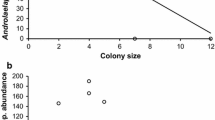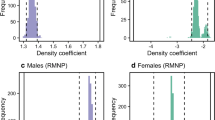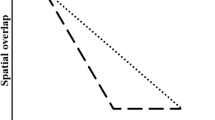Abstract
Sociality is poorly understood in the context of population processes. We used wild, female elk (Cervus canadensis) equipped with proximity-logging radio collars (n = 62) from Manitoba, Canada (2007–2009), to test for modifying effects of population density (two areas: 0.42 and 0.22 animals/km2) on the relationship between two measures of sociality. This included the rate at which collared individuals encountered one another per year (encounters logged as animals ranging to within 1.4 m of each other) and the extent to which animals overlapped in annual home range (proportion of shared minimum convex polygon ranges). Overlap was significantly greater in the high density area compared to that of the low, but not if we only considered individuals that directly encountered each other, implying that familiar individuals will maintain a constant degree of range overlap regardless of density. Encounter rate was nonlinearly related to home range overlap. This relationship was also density-dependent, exhibiting negative density dependence at high proportions of overlap, primarily in the high density subpopulation. Sociality, as defined by two interacting measures of behaviour—encounter rate and home range overlap—exhibits a complex nonlinear relationship; we discuss the implications of these results as they pertain to sociobiology, resource competition, and pathogen transmission.


Similar content being viewed by others
References
Albon SD, Stien A, Irvine RJ, Langvatn R, Ropstad E, Halvorsen O (2002) The role of parasites in the dynamics of a reindeer population. Proc R Soc Lond B 269:1625–1632
Barton K. (2010) MuMIn: multi-model inference version 0.13.1 http://CRAN.R-project.org/package=MuMIn
Bateman AW, Ozgul A, Coulson T, Clutton-Brock TH (2012) Density dependence in group dynamics of a highly social mongoose, Suricata suricatta. J Anim Ecol 81:628–639
Brashares JS, Werner JR, Sinclair ARE (2010) Social “meltdown” in the demise of an island endemic: allee effects and the Vancouver Island marmot. J Anim Ecol 79:965–973
Brook RK, McLachlan SM (2006) Factors influencing farmers’ concerns regarding bovine tuberculosis in wildlife and livestock around Riding Mountain National Park. J Environ Manage 80:156–166
Brook RK, Vander Wal E, van Beest FM, McLachlan SM (2013) Use of cattle winter feeding areas by elk and white-tailed deer: implications for managing bovine tuberculosis transmission risk from the ground up. Prev Vet Med 108:137–147
Burnham KP, Anderson DR (2002) Model Selection and Multimodel Inference: A Practical Information-Theoretic. Springer, New York
Caley P, Spencer NJ, Cole RA, Efford MG (1998) The effect of manipulating population density on the probability of den-sharing among common brushtail possums, and the implications for transmission of bovine tuberculosis. Wildlife Res 25:383–392
Caners RT, Kenkel NC (2003) Forest stand structure and dynamics at Riding Mountain National Park, Manitoba, Canada. Community Ecol 4:185–204
Carpenter FL, Macmillen RE (1976) Threshold model of feeding territoriality and test with a Hawaiian honeycreeper. Science 194:639–642
Cattet MRL, Caulkett NA, Wilson C, Vandenbrink T, Brook RK (2004) Intranasal administration of xylazine to reduce stress in elk captured by net gun. J Wildlife Dis 40:562–565
Chaverri G, Gamba-Rios M, Kunz TH (2007) Range overlap and association patterns in the tent-making bat Artibeus watsoni. Anim Behav 73:157–164
Christianson DA, Creel S (2007) A review of environmental factors affecting elk winter diets. J Wildlife Manage 71:164–176
Clutton-Brock TH, Guinness FE, Albon SD (1982) Red Deer: Behavior and Ecology of Two Sexes. University of Chicago Press, Chicago
Côté IM, Poulin R (1995) Parasitism and group size in social animals: a meta-analysis. Behav Ecol 6:159–165
Couzin ID (2006) Behavioral ecology: social organization in fission–fusion societies. Curr Biol 16:R169–R171
Cross PC, Creech TG, Ebinger MR, Heisey DM, Irvine KM, Creel S (2012) Wildlife contact analysis: emerging methods, questions, and challenges. Behav Ecol Sociobiol 66:1437–1447
Cross PC, Creech TG, Ebinger MR, Manlove K, Irvine KM, Henningsen J, Rogerson JD, Scurlock BM, Creel S (2013) Female elk contacts are neither frequency nor density dependent. Ecology 94:2076–2086
Dahle B, Swenson JE (2003) Home ranges in adult Scandinavian brown bears (Ursus arctos): effect of mass, sex, reproductive category, population density and habitat type. J Zool 260:329–335
Dubost G (1970) L’organisation spatiale et sociale de Muntiacus reevesi Ogilby 1839 en semi-liberté. Mammalia 34:331–355
Erlinge S, Hoogenboom I, Agrell J, Nelson J, Sandell M (1990) Density-related home-range size and overlap in adult field voles (Microtus agrestis) in southern Sweden. J Mammal 71:597–603
Ferron J, Ouellet JP (1989) Temporal and intersexual variations in the use of space with regard to social organization in the woodchuck (Marmota monax). Can J Zool 67:1642–1649
Fortin D, Fortin M-E, Beyer HL, Duchesne T, Courant S, Dancose K (2009) Group-size-mediated habitat selection and group fusion–fission dynamics of bison under predation risk. Ecology 90:2480–2490
Franklin WL, Mossman AS, Dole M (1975) Social organization and home range of Roosevelt elk. J Mammal 56:102–118
Franks DW, Ruxton GD, James R (2010) Sampling animal association networks with the gambit of the group. Behav Ecol Sociobiol 64:493–503
Gerard J-F, Loisel P (1995) Spontaneous emergence of a relationship between habitat openness and mean group size and its possible evolutionary consequences in large herbivores. J Theor Biol 176:511–522
Goodman EL (2007) Quantifying interactions in a high-density badger (Meles meles) population. Dissertation, University of York
Haydon DT, Morales JM, Yott A, Jenkins DA, Rosatte R, Fryxell JM (2008) Socially informed random walks: incorporating group dynamics into models of population spread and growth. Proc R Soc Lond B 275:1101–1109
Hebblewhite M, Pletscher DH (2002) Effects of elk group size on predation by wolves. Can J Zool 80:800–809
Hinde RA (1976) Interactions, relationships and social structure. Man 11:1–17
Hurlbert SH (1984) Pseudoreplication and the design of ecological field experiments. Ecol Monogr 54:187–211
Ji W, White PCL, Clout MN (2005) Contact rates between possums revealed by proximity data loggers. J Appl Ecol 42:595–604
Kjaer LJ, Schauber EM, Nielsen CK (2008) Spatial and temporal analysis of contact rates in female white-tailed deer. J Wildlife Manage 72:1819–1825
Krause J, Ruxton G (2002) Living in Groups . Oxford University Press, Oxford
Lloyd-Smith JO, Cross PC, Briggs CJ, Daughtery M, Getz WM, Latto J, Sanchez MS, Simth AB, Swei A (2005) Should we expect population thresholds for wildlife disease? Trends Ecol Evol 20:511–519
Manly BFJ (1998) Randomization, Bootstrap and Monte Carlo Methods in Biology. Chapman and Hall, London
Matthysen E (2005) Density-dependent dispersal in birds and mammals. Ecography 28:403–416
McCallum H, Barlow N, Hone J (2001) How should pathogen transmission be modelled? Trends Ecol Evol 16:295–300
McLoughlin PD, Ferguson SH, Messier F (2000) Intraspecific variation in home range overlap with habitat quality: a comparison among brown bear populations. Evol Ecol 14:39–60
Millspaugh JJ, Brundige GC, Gitzen RA, Raedeke KJ (2004a) Herd organization of cow elk in Custer State Park, South Dakota. Wildlife Soc B 32:506–514
Millspaugh JJ, Gitzen RA, Kernohan BJ, Larson MA, Clay CL (2004b) Comparability of three analytical techniques to assess joint space use. Wildlife Soc B 32:148–157
Mobæk R, Mysterud A, Loe LE, Holand Ø, Austrheim G (2012) Experimental evidence of density dependent activity pattern of a large herbivore in an alpine ecosystem. Oikos 121:364–1369
Morris DW (2003) Toward an ecological synthesis: a case for habitat selection. Oecologia 136:1–13
Moyle K, Johnston D, Knott B, Melville-Smith R, Walker D (2009) Effect of stocking density on the growth, survival, and behavior of postpuerulus western rock lobster, Panulirus cygnus (George) (Decapoda: Palinuridae). J World Aquac Soc 40:255–265
Nielsen CK, Woolf A (2001) Spatial organization of bobcats (Lynx rufus) in Southern Illinois. Am Midl Nat 146:43–52
Nishi JS, Shury T, Elkin BT (2006) Wildlife reservoirs for bovine tuberculosis (Mycobacterium bovis) in Canada: strategies for management and research. Vet Microbiol 112:215–338
Ostfeld RS, Lidicker WZ, Heske EJ (1985) The relationship between habitat heterogeneity, space use, and demography in a population of California voles. Oikos 45:433–442
Pépin D, Gerard J-F (2008) Group dynamics and local population density dependence of group size in the Pyrenean chamois, Rupicapra pyrenaica. Anim Behav 75:361–369
Pettit-Riley R, Estevez I, Russek-Cohen E (2002) Effects of crowding and access to perches on aggressive behaviour in broilers. App Anim Behav Sci 79:11–25
Prange S, Jordan T, Hunter C, Gehrt SD (2006) New radiocollars for the detection of proximity among individuals. Wildlife Soc B 34:1333–1344
R Development Core Team (2012) R: A Language and Environment for Statistical Computing. R Foundation for Statistical Computing, Vienna
Ramsey D, Spencer N, Caley P, Efford M, Hansen K, Lam M, Cooper D (2002) The effects of reducing population density on contact rates between brushtail possums: implications for transmission of bovine tuberculosis. J Appl Ecol 39:806–818
Rieucau G, Giraldeau L-A (2011) Exploring the costs and benefits of social information use: an appraisal of current experimental evidence. Philos T R Soc Lond B 366:949–957
Robert K, Garant D, Pelletier F (2012) Keep in touch: does spatial overlap correlate with contact rate frequency? J Wildlife Manage 76:1670–1675
Robert KR, Garant D, Vander Wal E, Pelletier F (2013) Context-dependent social behaviour: testing the interplay between season and kinship with raccoons. J Zool 290:199–207
Rodgers AR, Carr AP, Smith L, Kie J (2005) Home Range Tools for ArcGIS 9.x. Ontario Ministry of Natural Resources. Centre for Northern Forest Ecosystem Research, Thunder Bay, Ontario
Rowe JS (1972) Forest Regions of Canada. Information Canada, Ottawa, Ontario
Ruckstuhl KE, Festa-Bianchet M (2001) Group choice by subadult bighorn rams: trade-offs between foraging efficiency and predator avoidance. Ethology 107:161–172
Schauber EM, Storm DJ, Nielsen CK (2007) Effects of joint space use and group membership on contact rates among white-tailed deer. J Wildlife Manage 71:155–163
Shury TK, Bergeson G (2011) Lesion distribution and epidemiology of Mycobacterium bovis in elk and white-tailed deer in south-western Manitoba, Canada. Vet Med Int 2011: Article ID 591980, 11 pages
Steury TD, Murray DL (2003) Causes and consequences of individual variation in territory size in the American red squirrel. Oikos 101:147–156
Tompkins DM, Dunn AM, Smith MJ, Telfer S (2011) Wildlife diseases: from individuals to ecosystems. J Anim Ecol 80:19–38
Vander Wal E (2011) Sex, friends, and disease: the social ecology of elk (Cervus elaphus) with implications for pathogen transmission. Dissertation, University of Saskatchewan
Vander Wal E, McLoughlin PD, Brook RK (2011) Spatial and temporal factors influencing sightability of elk. J Wildlife Manage 75:1521–1526
Vander Wal E, Yip H, McLoughlin PD (2012a) Sex-based differences in density-dependent sociality: an experiment with a gregarious ungulate. Ecology 93:206–212
Vander Wal E, Paquet PC, Andrés JA (2012b) Influence of landscape and social interactions on transmission of disease in a social cervid. Mol Ecol 21:1271–1282
Vander Wal E, van Beest FM, Brook RK (2013a) Density-dependent effects of group size are sex-specific in a gregarious ungulate. PLoS ONE 8:e53777
Vander Wal E, Edye I, Paquet PC, Coltman DW, Bayne E, Brook RK, Andrés JA (2013b) Juxtaposition between host population structures: implications for pathogen transmission in a cervid community. Evol Appl 6:1001–1011
Vander Wal E, Paquet PC, Messier F, McLoughlin PD (2013c) Effects of phenology and sex on social proximity in a gregarious ungulate. Can J Zool 91:601–609
Walrath R, Van Deelen TR, VerCauteren KC (2011) Efficacy of proximity loggers for detection of contacts between maternal pairs of white-tailed deer. Wildlife Soc B 35:452–460
Weckerly FW (1999) Social bonding and aggression in female Roosevelt elk. Can J Zool 77:1379–1384
White TCL (2004) Limitation of populations by weather-driven changes in food: a challenge to density-dependent regulation. Oikos 105:664–666
White PCL, Harris S (1994) Encounters between red foxes (Vulpes vulpes): implications for territory maintenance, social cohesion and dispersal. J Anim Ecol 63:315–327
Whitehead H (1997) Analysing animal social structure. Anim Behav 53:1953–1067
Whitehead H, Dufault S (1999) Techniques for analyzing vertebrate social structure using identified individuals: review and recommendations. Adv Stud Behav 28:33–74
Wilson EO (1975) Sociobiology: The New Synthesis. Belknap, Cambridge, Massachusetts
Wronski T, Apio A (2006) Home-range overlap, social vicinity and agonistic interactions denoting matrilineal organisation in bushbuck, Tragelaphus scriptus. Behav Ecol Sociobiol 59:819–828
Acknowledgments
Funding and logistical support was provided primarily by Parks Canada Agency, the Natural Science and Engineering Research Council of Canada (F. Messier, P.D. McLoughlin), and PrioNet Canada. P. Simpson and B. Simpson adroitly flew elk relocation flights and C. Wilson, T. Vandenbrink, and T. Shury efficiently and safely handled elk. R. Grzela, S. McKay, R. Robinson, S. Johnstone, J. Dillabough, B. Blackbird, S. Boychuk, S. Helms, A. Ledden, and M. Benson assisted with monitoring collared animals. Thanks to T. Sallows, D. Bergeson, and K. Kingdon at Parks Canada for their commitment to this research and to F. Messier, R. K. Brook, and F. Pelletier for support while writing this manuscript. Also, thanks to Kathreen Ruckstuhl and a number of anonymous reviewers whose suggestions markedly improved our work.
Ethical Standards
Our study, which occurred in Canada, complied with the current laws of the country at the time. Our research followed Animal Care Protocol #20060067 of the University of Saskatchewan following the guidelines of the Canadian Council on Animal Care.
Author information
Authors and Affiliations
Corresponding author
Additional information
Communicated by K. E. Ruckstuhl
Author contributions
EVW conceived and designed the study. EVW collected the data. EVW and MPL analysed the data. EVW, MPL, and PDM interpreted the results. EVW, MPL, and PDM wrote and critically revised the manuscript.
Electronic supplementary material
Below is the link to the electronic supplementary material.
ESM 1
(PDF 540 kb)
Rights and permissions
About this article
Cite this article
Vander Wal, E., Laforge, M.P. & McLoughlin, P.D. Density dependence in social behaviour: home range overlap and density interacts to affect conspecific encounter rates in a gregarious ungulate. Behav Ecol Sociobiol 68, 383–390 (2014). https://doi.org/10.1007/s00265-013-1652-0
Received:
Revised:
Accepted:
Published:
Issue Date:
DOI: https://doi.org/10.1007/s00265-013-1652-0




